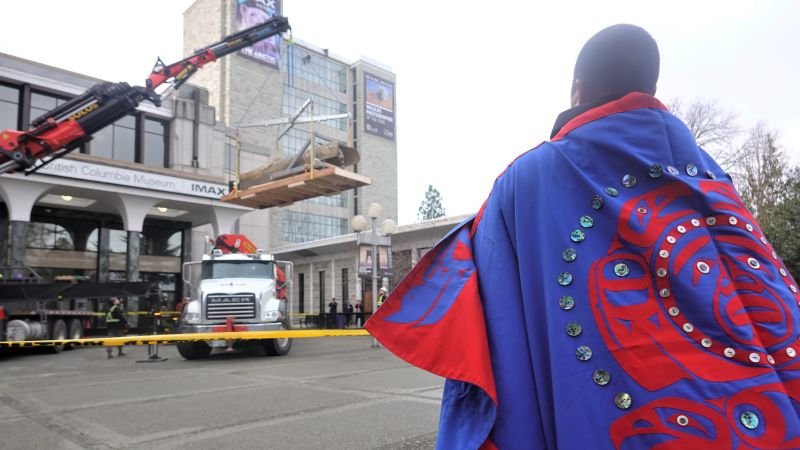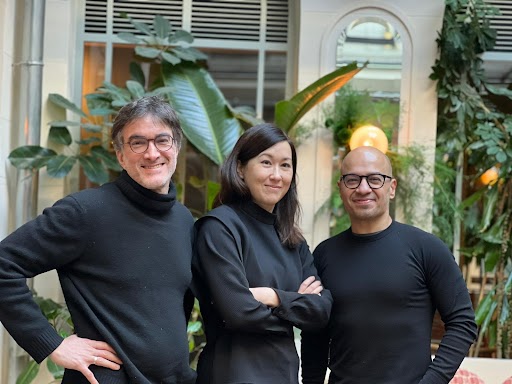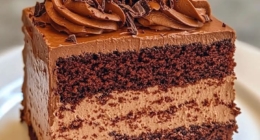CNN —
A totem pole removed from an Indigenous burial site and displayed in a Canadian museum more than a century ago has been repatriated to the Nuxalk Nation.
More than 100 Nuxalkmc traveled more than 600 miles from Bella Coola, British Columbia to Victoria to retrieve her totem pole from the Royal BC Museum and return it to its rightful home on Monday.
When the totem pole was lifted from the museum and lowered to the ground, Nuxalkmc returned to Mother Earth for the first time, and Nuxalkmc sang the Thunder Song – followed by women blessing and reawakening the spirit of the totem.
“We all cried when it landed on the ground,” Nuxalk Hereditary Chief Deric Snow told CNN. “It was that feeling when your emotions hit the peak of your life. I never thought we would be able to do that.”
The totem pole was carved in the mid-1800s by Snow’s great-grandfather, Snuxyaltwa Louie Snow, whose spirit lingers in the totem pole and will not rest until it is returned to its ancestral home, the chief said.
“The people who carved their totem poles were so spiritual, they were chosen to carve, they asked the tree to surrender to them before they carved it, they had visions of what to put there,” Snow said. “Everything in the Royal BC Museum is sacred because it was created by gifted people and their souls are still within them.”
The totem pole, which served as an entrance pole for a longhouse and then as a grave post, was removed from a burial site, according to museum records, and sold to the museum in 1913 for CA$45. According to Snow, the stake was one of many artifacts left behind when the smallpox epidemic drove the indigenous people from their homelands in the 1900s.
Because tradition holds that the carver’s spirit resides forever in her totem pole, 110 years of preservation in a museum meant Snow’s great-grandfather’s spirit was trapped in a gallery space, Snow said.
“To us, museums are like the boarding schools where our children were killed,” Snow said. “They have human remains in the Royal BC Museum and the ghosts of those human remains are there. It’s a kind of pain we can’t put into words.”
In 2022, during his fight to get the totem pole back from the museum — as well as a second totem pole and a war canoe that he says his great-grandfather also carved — Snow lost his wife, brother, and sister.
“It was a very difficult time and we weren’t supposed to be working,” Snow said. “But we got through it by remembering who we’re doing it for and doing it with love. I know my wife is in heaven, smiling down and rejoicing with us. ”
Snow first applied for the totem pole’s repatriation after seeing it at the museum in 2019. After years of debate, he filed a lawsuit against the museum in February 2022, hoping to expedite his return.
“The museum made a commitment to returning the stake in 2019, but this particular case has presented some challenges that have lengthened the process,” the Royal BC Museum told CNN. “There was a careful process of confirming ownership and the need to draw up a plan to remove the mast on the third floor of the museum. Covid-19 also caused a delay.”
The museum said staff worked closely with Snow “to create a safe plan for removing the pole from the First Peoples Gallery,” which involved a team of engineers, conservationists and experts.
“We will continue discussions with the Nuxalk Nation about other properties as soon as we are able,” the museum said, adding that they have repatriation requests from 30 other indigenous tribes in the province.
A convoy of more than 60 cars followed the vehicle carrying the totem pole during its 14-hour drive home. On the journey, the Nuxalkmc stopped to visit seven other First Nation tribes so they could see the totem pole and feel its energy. and bless it with sage and cedar bow.
“Totem Poles tell you everything about your life and why you are here on Mother Earth. We are here to live, but also to be the voice of all life,” Snow said. “We speak for every living thing on Mother Earth, including the water, the air, the mountains, the entire animal kingdom, and every nation is reminded of this just by walking past them with a totem pole.”
Some of the tribes also held the Nuxalkmc, celebrating together with festivals, singing, drumming and dancing to honor the reawakened spirit and rejoice in the victory of the totem pole’s return.
“This is the beginning,” Trevor Mack, a member of the Tsilhqot’in nation who attended one of the celebrations when the pole began its journey, told CNN. “Museums across the western world – whether in Victoria, Chicago, New York, London, Paris – must prepare for the stolen objects to be called home in their glass cases, where they belong.”
While the healing process for tribal peoples involves bringing back all that was taken from them, celebrations like those inspired by the return of the totem pole are just as important.
Its impact was visible in the laughter and weeping of the hundreds of tribesmen who came out to honor the Pole’s journey with the Williams Lake First Nation in the Secwepemc Territory, one of the tribes the convoy visited along the way.
The celebration began outside with two bonfires lit while elderly tribal women blessed everyone with a healing song. Then they took fur bows and blessed the pole while the elders drummed.
“As we drummed the welcome song, suddenly, without being asked, the older women of our nation stood up and began the welcome dance,” Williams Lake First Nations Chief Willie Sellars told CNN. “It broke me. It got very emotional for a lot of people because we don’t experience things like that very often.”
“The legacy and history of boarding schools and the trauma inflicted on my ancestors and elders who are alive today has never left us,” he added. “To see that they are still able to hold on to our traditions and pass them on from generation to generation makes them so proud to be Indigenous.”
In recent times, most of the large gatherings in Indigenous communities have been funerals, particularly in the wake of the Covid-19 pandemic which has devastated Indigenous communities struggling for resources and medical supplies.
For so many different tribes to unite in joyful celebration rather than mourning, Sellars says was a “moment that meant everything.” It was also a reminder of what life was like for their ancestors before so much was taken from them.
“Historically we gathered as nations and we celebrated until we were not allowed to perform the ceremonies or speak our language or sing our songs,” Sellars said. “It’s so emotional because it means we’re finally going in the right direction. This totem pole is a beacon of hope for all of us.”
The following day the stake was blessed by the elders of the Tsilhqot’in congregation in Tl’etinqox. After that, the pole and convoy hiked down a snow-covered mountain road back to Bella Coola.
The totem pole will stand at Acwsalcta School on the reservation in Bella Coola until May 5, 2024 for a final resurrection ceremony of Snow’s great-grandfather in honor of his wife, who died on that date last year. The totem pole is then returned to its original location in South Bentinck.
“Every time something comes back to us, we get more and more of our stories back,” Snow said. “It’s about time the Canadian government saw us as human beings. They all know what was stolen and they must return what they took.”
Don’t miss interesting posts on Famousbio










